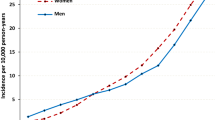Abstract
Background
Acute colonic diverticulitis is common in the Western world representing a growing burden on health care. We aimed to report the factual epidemiological and demographic characteristics in patients with acute diverticulitis in a large nationwide population.
Method
We conducted a population-based cohort study from 2000 to 2012 on the complete Danish population, which included all patients with acute colonic diverticulitis. Data were composed through two national longitudinal registries. The study main outcomes were demographic development regarding hospital admission, age, gender, geographical residency, and seasonal information.
Results
A total of 101,963 acute hospital contacts were identified from 2000 to 2012, of these 44,160 were due to acute diverticulitis. From 2000 to 2012, overall admission rates for complicated diverticulitis increased significantly with 42.7%. There was a small increase in hospital admissions due to acute diverticulitis, and uncomplicated diverticulitis accounted for 83–88% of all admissions. No significant development was seen in cases of uncomplicated diverticulitis. The majority of patients were older than 50 years (85%) and 60% were women. The male gender dominated in patients younger than 50 years (58%), whereas women dominated above 50 years (63%). Mean age and dominating age group decreased significantly from 2000 to 2012 for both genders. A significantly larger proportion of male patients had complicated diverticulitis than uncomplicated diverticulitis. Most admissions were seen during autumn.
Conclusion
We found that acute colonic diverticulitis has been progressing over the last decade with more severe cases of disease. Our findings underline the need for further research to identify the relevant risk factors and causal circumstances.





Similar content being viewed by others
References
Peery AF, Keku TO, Martin CF et al (2016) Distribution and characteristics of colonic diverticula in a United States screening population. Clin Gastroenterol Hepatol 14:980–985
Hinchey EJ, Schaal PG, Richards GK (1978) Treatment of perforated diverticular disease of the colon. Adv Surg 12:85–109
Etzioni DA, Mack TM, Beart RW et al (2009) Diverticulitis in the United States: 1998-2005: changing patterns of disease and treatment. Ann Surg 249:210–217
Warner E, Crighton EJ, Moineddin R et al (2007) Fourteen-year study of hospital admissions for diverticular disease in Ontario. Can J Gastroenterol 21:97–99
Lynge E, Sandegaard JL, Rebolj M (2011) The Danish National Patient Register. Scand J Public Health 39:30–33
Pedersen CB (2011) The Danish Civil Registration System. Scand J Public Health 39:22–25
Kircher MF, Rhea JT, Kihiczak D, Novelline RA (2002) Frequency, sensitivity, and specificity of individual signs of diverticulitis on thin-section helical CT with colonic contrast material: experience with 312 cases. AJR Am J Roentgenol 178:1313–1318
Pradel JA, Adell JF, Taourel P, Djafari M, Monnin-Delhom E, Bruel JM (1997) Acute colonic diverticulitis: prospective comparative evaluation with US and CT. Radiology 205:503–512
Paterson HM, Arnott ID, Nicholls RJ, Clark D, Bauer J, Bridger PC, Crowe AM, Knight AD, Hodgkins P, Solomon D, Dunlop MG (2015) Diverticular disease in Scotland: 2000-2010. Color Dis 17:329–334
Hjern F, Wolk A, Håkansson N (2012) Obesity, physical inactivity, and colonic diverticular disease requiring hospitalization in women: a prospective cohort study. Am J Gastroenterol 107:296–302
Crowe FL, Appleby PN, Allen NE, Key TJ (2011) Diet and risk of diverticular disease in Oxford cohort of European Prospective Investigation into Cancer and Nutrition (EPIC): prospective study of British vegetarians and non-vegetarians. BMJ 343:d4131
Hjern F, Wolk A, Håkansson N (2011) Smoking and the risk of diverticular disease in women. Br J Surg 98:997–1002
Strate LL (2012) Lifestyle factors and the course of diverticular disease. Dig Dis 30:35–45
Tønnesen H, Engholm G, Moller H (1999) Association between alcoholism and diverticulitis. Br J Surg 86:1067–1068
Wolf C (2012) Diverticulitis: the relationship between body mass index and disease location, recurrence, and complications. Gastroenterol Nurs 35:46–51
Wheat CL, Strate LL (2016) Trends in hospitalization for diverticulitis and diverticular bleeding in the United States from 2000 to 2010. Clin Gastroenterol 14:96–103
Greenwood-Ericksen M, Havens J, Ma J, Weissman J, Schuur J (2016) Trends in hospital admission and surgical procedures following ED visits for diverticulitis. West J Emerg Med 17:409–417
Nguyen GC, Sam J, Anand N (2011) Epidemiological trends and geographic variation in hospital admissions for diverticulitis in the United States. World J Gastroenterol 17:1600–1605
Author information
Authors and Affiliations
Corresponding author
Ethics declarations
Data retrieval and analysis was approved by the Danish Data Protection Agency (number HEH-2013-056).
Rights and permissions
About this article
Cite this article
Hupfeld, L., Pommergaard, HC., Burcharth, J. et al. Emergency admissions for complicated colonic diverticulitis are increasing: a nationwide register-based cohort study. Int J Colorectal Dis 33, 879–886 (2018). https://doi.org/10.1007/s00384-018-3078-7
Accepted:
Published:
Issue Date:
DOI: https://doi.org/10.1007/s00384-018-3078-7




